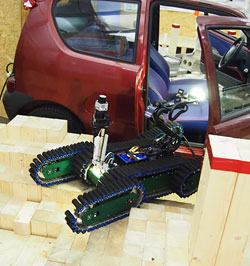
RoboCup Rescue is one of the competition leagues that make up the yearly RoboCup event.
Robocup is a robotics event that aims to stimulate robotics technology and to inspire people to get involved in robot development. To get people interested in a playfull way, the event uses competitions, demonstrations and educational games.
In this particular RoboCup Rescue League, teams from all over the world compete for the best robot for Search & Rescue missions. The idea behind the RoboCup Rescue games is to discover the different challenges involved in Search & Rescue operations, provide feedback of the usability of robots in disaster areas and to encourage teams to share experiences and learn from them.
RoboCup Rescue has two sub-leagues:
In the Rescue Robot League, the main objective is to design and build a robot that is capable of assisting human rescue teams in evaluating a disaster area, making a rescue plan and help during the actual rescue mission.
The following capabilites will be tested:
In order to test these capabilities of the robots involved, a disaster site has been simulated that consist of several color-coded areas. Each of these areas, or arenas, contains a specific challenge that has to be dealt with.
The Rescue Simulation competition revolves around disaster evaluation, planning and execution of the rescue operation in a simulated disaster scenario.
The ultimate goal for the Simulation League is to develop robotsystems capable of scanning the disaster area, map it and evaluate the situation accuratly to minimize the risk of danger for the rescue teams.
Then, the right team needs to be assembled and directed while exchanging information between the coordinators and the rescue teams.
The Simulation has two main tasks:
Simulators that need to be developed are:
- Traffic simulators, to enforce traffic rules, simulate traffic movement, speed and direction including traffic jams.
- Fire Simulators, to simulate fires. They take into account the propagation of fire related to the properties of buildings, wind direction, and water content.
- Civilian Simulators, to simulate the behaviour of civilians such as movement along roads.
Apart from this, software programs (called "agents") are developed to act as Police Forces, Fire Brigades, and Ambulance Teams each with their own behavior and capabilities.